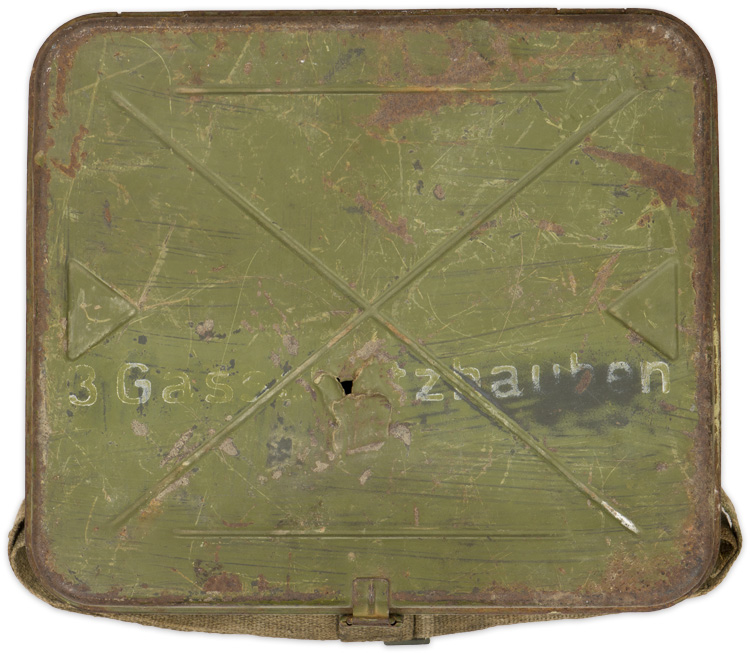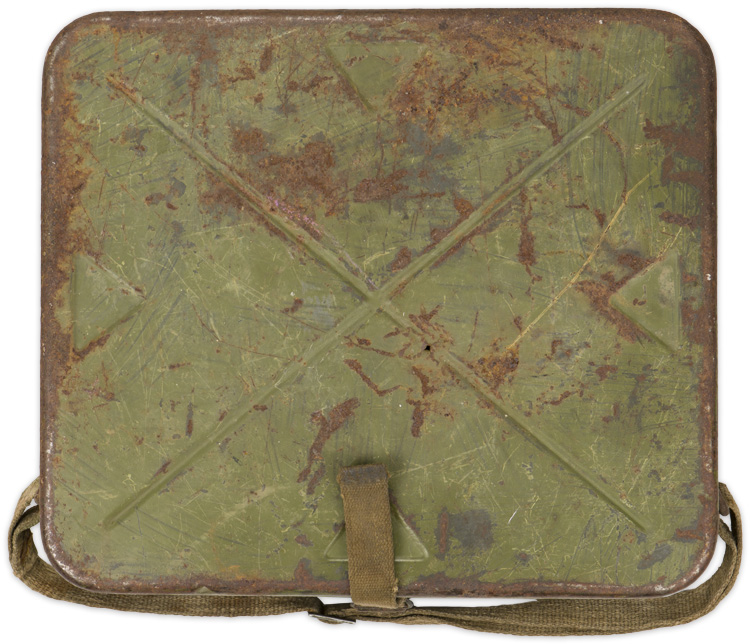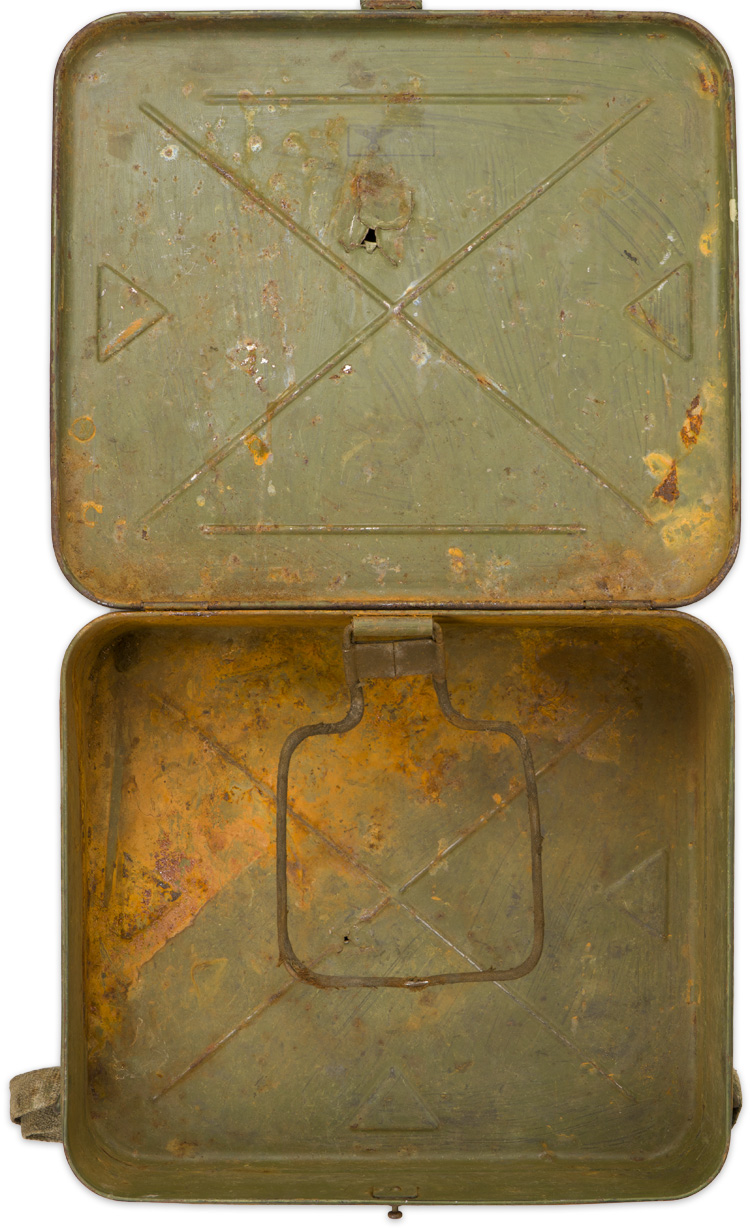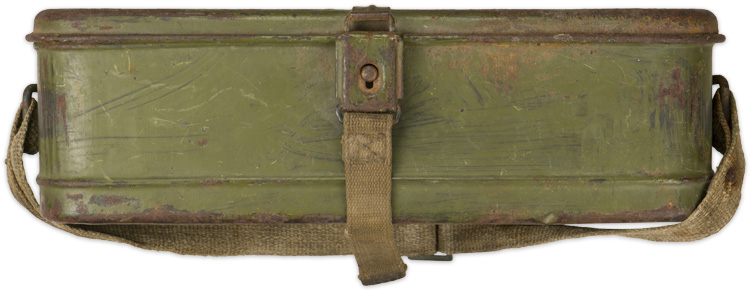





H076561 HEAD WOUND GASMASK CASE.
(Kasten für Gasschutzhaube)BACKGROUND: With the development of poisonous gasses used as offensive weapons in WWI appropriate defensive gasmasks also had to be developed. The German WWI M1915 and M1917 gasmasks evolved into the Weimar Reichswehr, (National Defence Force, Circa 1919-1933), era M24 gasmask and eventually into the M30 and M38 gasmasks used in WWII. All German Army personnel were issued with a gasmask, carrying canister and accessories and were required to have it readily available at all times. Although the use of chemical warfare agents was considered by the German OKW, Oberkommando der Wehrmacht, (High Command of the Armed Forces), fear of Allied retribution forced them to reconsider and shelf the idea. Fear of the potential use of chemical warfare agents made the gasmask and canister a constant companion of the German soldier through-out the war. Each Divisional sized unit within the German Army of WWII had support units which included a medical unit that normally consisted of two companies, a mobile field hospital and two ambulance platoons. Within these medical units EM’s and Junior NCO’s with basic medical training acted as medical orderlies or stretcher bearer’s under the command of Doctors with Officer’s ranks. The German Army also maintained static hospitals in the rear areas for those with more severe wounds and those with the most serious injuries, that would require long rehabilitation times, would be sent to a hospital in their home military recruiting district within Greater Germany. Generally the German field units preferred to care for their own wounded as much as possible as a convalescents transferred to a rear area, static, military or home military district hospital could potentially be dispatched to a new unit on their recovery. As a result most of the Divisional medical support units maintained a generous supply of medical equipment and accessories to provide the most favorable "in-house" care as possible. Among the medical equipment and accessories were a wide variety of bandages, wound dressings, numerous, assorted, first-aid items including a specially developed gasmask for personnel that had suffered head wounds. Both the M30 and the M38 gasmasks were designed to fit snugly on the wearer’s head and as a result, were unsuitable for personnel that had suffered head wounds, which led to the development of a special gasmask that was introduced on November 7TH 1940 and was designed specifically for individuals suffering from head wounds. These special head wound gasmasks were carried by the divisional support units medical section and normally came housed in specially designed, metal containers, that held one to three of the gasmasks. The full coverage, head wound gasmasks were designed to be loose fitting so as not to apply any pressure on the wearer’s head and still provide adequate protection. The head wound gasmasks were manufactured in a pliable rubber in "one size fits all", covering the whole head of the wearer and secured around the neck with tie tapes. The head wound gasmasks utilized one of the standard three, Filter Einsatz, (Filter Insert), breathing filters, the FE37, FE41 or the FE42.
PHYSICAL DESCRIPTION: Roughly, 3 7/8" x 12 1/2" x 10 3/4", (9.7 cm x 31.6 cm x 27.2 cm), green over-painted, stamped, magnetic sheet metal construction case for three, head wound gasmasks. The case has a fold back, top lid with dual, brazed on, hinges with an internal bar to the reverse and a brazed on spring activated closure clip to the obverse. The closure clip has a woven, field-grey, canvas web pull tab and attaches to a rivetted on stud, positioned on the obverse body of the case. The top of the case has a large impressed, "X", two, impressed, straight lines and two, small, impressed triangles while the bottom of the case has a large impressed, "X", and four, small, impressed, triangles for added strength. The top lid has the faint, partially illegible, white, stenciled designation, that appears to be, "3 Gasschutzhauben", (3 Gas Protection head dress). Both sides of the case have brazed on, extended, metal loops for a carrying strap and comes complete with a woven, field-grey, canvas web carrying strap with a sheet metal, split pin, securing rivet, and a sliding, open rectangular, alloy, length adjustment buckle. One side of the case is well marked with an impressed waffen-amt and the manufacturer’s two letter code and date, "an 41", indicating manufacture by C. Beuttenmüller & Cie GmbH Metallwaren/Munition of Bretten in 1941. The interior of the case has a black inkstamped waffen-amt and a brazed on, fabric covered, spring active, swivel, heavy, wire bar to secure the contents in place. The case retains about 75% of it’s crudely, hand brushed, applied, green over-paint with small spots of wear to the original, underlying, field-grey paint and the base metal with areas of moderate to heavy surface spotting. The green over-paint appears to have been period applied. Both the top and bottom of the case have small puncture holes. Seldom encountered head wound gasmask case.
GRADE *** PRICE $69.00
To Order this item, please use one of the two e-mail addresses below to contact us. Please make sure to quote the item number in your e-mail
MILITARIA WANTED! If you have items for sale, please contact us. We specialize in selling single pieces and entire collections. Over 3 decades in the business and we do all the work for you. Get the best return for your investment.
-E-Mail Address pawmac@nbnet.nb.ca Or guild@nb.aibn.com
To return to the main page please CLICK below